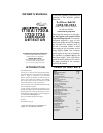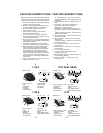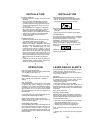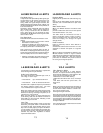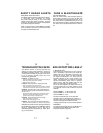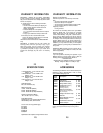
19 20
SPEED MONITORING
•
Because you vehicle’s license plate or headlights are the
laser gun’s primary targets, mounting your Whistler
detector on the dashboard can improve laser detection at
short range.
•
Do not follow closely behind any vehicle you cannot see
through. If you can’t see past a vehicle ahead of you,
chances are your detector won’t either.
•
The receiving range of your laser detector will not be the
same as a radar detector. Laser guns are most often used
at short range.
Whistler Laser/Radar detectors receive all current laser guns
which operate at a laser wavelength of 905 +/- 10mm.
•
Pro Laser
™
I II III
•
LT1 20-20
•
Ultra Lyte
Other Speed Detection Systems
Several techniques other than radar or laser are used to
measure vehicle speeds. When these methods are being
used, no detector can provide a warning. These techniques
include:
•
Pacing - A patrol car drives behind you and matches your
driving speed.
•
Vascar/Aircraft - The time it takes a vehicle to travel a
known distance is measured.
SPEED MONITORING
Radar Facts
A radar gun operates by transmitting radio waves at certain
frequencies which reflect off objects and are then picked up
by the radar gun’s receiving section. When a radar beam
reflects off a moving target, a measurable frequency shift
occurs. The radar unit converts this shift into miles per hour
to determine your vehicle’s speed. Currently, the FCC
(Federal Communications Commission) permits operation of
traffic radar guns at X Band (10.500 - 10.550 GHz), K Band
(24.050 - 24.250 GHz), and Ka Band (33.400 - 36.000 GHz).
Note: A radar detector will not alarm if an officer is not
transmitting on any one of the above radar bands.
Laser Facts
It’s well documented that many radar guns cannot reliably
provide the speed of a targeted vehicle that is traveling in
a group of vehicles. In contrast, a laser gun can target a
specific vehicle out of a line of traffic and determine its
speed. The advantage of laser over radar in terms of target
identification is the result of the laser gun’s narrow beam. A
radar transmission can cover more than a four-lane highway
at a distance of 1,000 feet, compared with a laser transmis-
sion which covers about 3 feet at the same distance. For
best protection, keep these points in mind:
21
Radar Detector Detectors (VG-2)
The Interceptor VG-2, or simply VG-2, is a microwave
receiver used by police to detect signals radiated by the
local oscillator of a radar detector. Because its purpose is
to identify persons driving with radar detectors, the VG-2
is known as a “radar detector detector”.
The VG-2 is the primary tool used by the police to
identify radar detector equipped vehicles. If caught, in a
state where detectors are illegal, (see page ??), drivers risk
losing their radar detector and receiving a fine. In
addition, instant-on radar is almost always used in
combination with a VG-2, leaving unsuspecting motorists
vulnerable to receiving two tickets - one potentially for
speeding, the other for possession of a detector.
Having a radar detector capable of detecting the VG-2
may alert you to the presence of a speed trap.
For more information on speed monitoring technologies,
please visit our FAQ page on our website:
www.whistlergroup.com
It is the responsibility of the individual radar detector
owner to know and understand the laws in your area
regarding the legality of the use of radar detectors.
SPEED MONITORING
22
WARRANTY INFORMATION
Consumer Warranty
This Whistler Laser/Radar detector is warranted to the
original purchaser for a period of one year from the date
of original purchase against all defects in materials and
workmanship. This limited warranty is void if the unit is
abused, modified, installed improperly, if the housing has
been removed, or if the serial number is missing. There
are no express warranties covering this product other than
those set forth in this warranty. All express or implied
warranties for this product are limited to one year.
Whistler is not liable for damages arising from the use,
misuse, or operation of this product.
Service Under Warranty
During the warranty period, defective units will be
repaired without charge to the purchaser when returned
with a dated store receipt to the address below. Units
returned without dated store receipt will be handled as
described in section
“Service Out Of Warranty.”
Due to the
specialized equipment necessary for testing a laser/radar
receiver, there are no authorized service stations for
Whistler brand detectors other than Whistler.
When returning a unit for service under warranty, please
follow these instructions:
1. Ship the unit in the original carton or in a suitable
sturdy equivalent, fully insured, with return receipt
requested to:
Whistler Repair Dept.
1201 North Dixieland Rd
Rogers, AR. 72756



